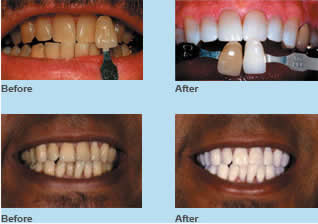Shelby Township Dentist Explains Teeth Whitening
In our Shelby Township dental practice one of the most requested cosmetic procedures is teeth whitening. I would like to clarify what whitening (bleaching) is and what it is not so that you the consumer can make an informed decision when it comes to getting a brighter smile.
Bleaching has been around in dentistry for the past 25 years or so. It was first discovered accidentally when an oral wound cleanser was discovered to have an effect on whitening the teeth. The active ingredients in both the wound cleaners and in bleaching agents are either carbamide peroxide or hydrogen peroxide. These agents have the ability of creating “scrubbing bubbles”, a phenomenon observed when pouring hydrogen peroxide over a bleeding wound. The bubbles kill off germs by breaking down the peroxide into oxygen, water and free radicals. Free radicals are small molecules that are very active in breaking down the structure of larger molecules.
Teeth become darker over time because large stain molecules are present within the structure of enamel. Over time these molecules will become larger and larger. Light reflects off of these molecules creating a dark appearance, so when bleaching agents penetrate the enamel they break the large stain molecules down into much smaller molecules which reflects a lighter image.
There are a few factors that make teeth whitening more effective:
1) Concentration and availability of active peroxide agents. The stronger the chemical the more active ingredient is available to oxidize to create more “scrubbing bubbles”.
2) Time to break down the larger stain molecule. The best techniques are those using the plastic bleaching trays custom made at the dental office. Usually wearing them at night allows for the best results.
3) Custom tray construction. This is important because it is critical that the bleaching material stays in contact with only the enamel of the teeth as long as possible and not covering the gum tissue or even the root of the teeth. If it is haphazardly made and are not precisely trimmed it will cause great tissue irritation, burning the tissue and causing tooth sensitivity. The tray should actually create a seal at the gum line so when gas pressure is emitted from the chemical process it can actually penetrate into the tooth.
There are many techniques used in whitening teeth including in office whitening strips, paint on agents, toothpaste and even floss. This is a huge industry so when there is money to be made many gimmicks and strategies are out there.
In my opinion the night whitening with precise custom trays work the best. I have the Zoom light to do “in office” bleaching but rarely use it. The reason why is that the factor of time is not present long enough to make this a long term solution. You always have to follow up the Zoom whitening with nightly bleaching to make this a long term technique. I have many patients who will complain that they had the Zoom done with no long term results to show for it because they were not informed that they had to whiten their teeth at night to gain the lasting effect. I also recommend nightly use of bleaching trays because at night the saliva flow is greatly reduced when you sleep. Saliva contains enzymes that break down the peroxides so the reduced saliva helps keep the material in the tray where it is most effectively needed.
The whitening strips do work, but they can’t fit into the nooks and crannies if the teeth are at all crooked. They also only cover the front 6 teeth so when one gives a big smile the back teeth are darker, which doesn’t look so good.
Teeth Whitening: Before and After
Tooth sensitivity is also a factor when it comes to teeth whitening. There are acidic preservatives added to some of the products used by dentists that make the bleaching material more stable and to prevent breakdown before use. The problem is that these agents can make the teeth more sensitive while not being active enough to break down when needed on the teeth. Rather than adding these acidic agents to the bleach, the Kor deep bleaching solution uses refrigeration to keep it active and preserved until needed. Hema, a common dental desensitizer is used before the bleaching process to reduce any sensitivity. All of these details are needed as well as a precise fitting tray to give you the deepest bleaching result possible.

There are many ways to whiten your teeth. What is important is the fact that your dentist can provide you the best outcome. Remember that only enamel can be whitened; tooth colored fillings, crowns and veneers can not be bleached out. Active decay must be taken care of before bleaching is done to reduce any possibility of root canals. The most important thing is that your dentist evaluates your situation to give you the professional guidance needed for the most predictable results.
Shelby Township Dentist Explains Teeth Whitening
If you have questions about this topic or any other topic you can email me, Dr. Antolak at DrAntolak@Thegentledentist.com or fax your question to Ask the Dentist c/o Robert Antolak DDS. The number is (586)247-1211. Or address is 15055 22 Mile, suite #2, Shelby Twp. MI 48315.
Just stop in during our office hours and let me know that you read our Ask the dentist article and get a free prize. Our office phone number is (586)247-3500.
May you and your family have a blessed Thanksgiving this year. During these tough economic times take time to see what God has blessed you with: Family, Friends and Freedom. What else could be better?
